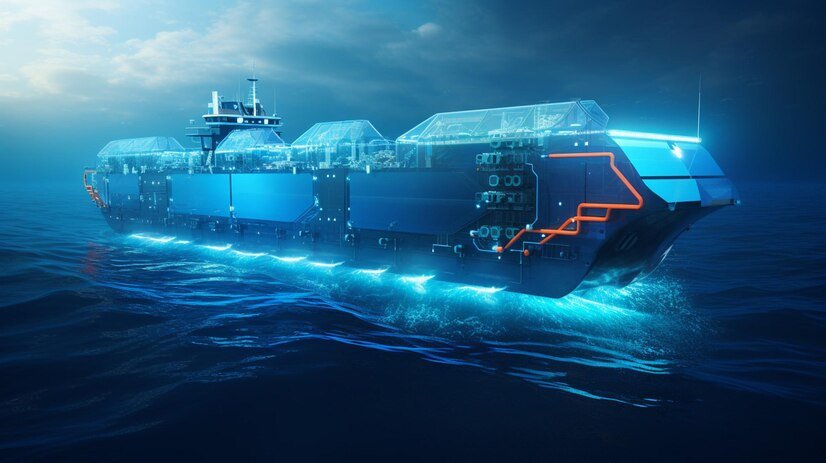The rapid advancement of Artificial Intelligence (AI) has begun to transform various industries, from healthcare and finance to entertainment and beyond.
One of the most intriguing and potentially revolutionary applications of AI is in the realm of maritime transportation. Autonomous shipping, powered by sophisticated AI technologies, is poised to reshape the future of global trade and naval operations.
Traditionally, maritime transportation has been the backbone of international commerce, responsible for the movement of goods across the world’s oceans.
Despite its critical importance, the industry faces numerous challenges, including human error, piracy, and environmental concerns. Autonomous shipping aims to address these issues by leveraging AI to create safer, more efficient, and environmentally friendly maritime operations.
In this blog, we will explore the current state of maritime transportation, delve into the concept of autonomous shipping, and examine how AI is being utilized to drive this transformation.
We will also discuss the benefits, challenges, and future trends of AI in autonomous shipping, providing a comprehensive overview of what lies ahead for this exciting technological frontier.
Role of AI in Autonomous Shipping

AI plays a crucial role in the development and operation of autonomous ships, bringing several advanced technologies together to create intelligent, efficient, and safe maritime transportation systems.
The integration of AI in autonomous shipping encompasses various aspects, including navigation, collision avoidance, route optimization, and overall vessel management. Here’s a closer look at how AI is driving this maritime revolution:
- Navigation and Control
- Machine Learning Algorithms: AI systems utilize machine learning algorithms to process vast amounts of data from onboard sensors, such as radar, sonar, and GPS, to understand and predict maritime conditions. These algorithms continuously learn from new data, improving their accuracy and reliability over time.
- Computer Vision: AI-powered computer vision systems enable autonomous ships to interpret visual data from cameras, allowing them to recognize and respond to other vessels, obstacles, and environmental conditions. This technology is essential for real-time decision-making and safe navigation.
- Autonomous Decision-Making: AI systems can make autonomous decisions based on real-time data analysis, determining the best course of action to ensure safe and efficient navigation. This includes adjusting speed, changing course, and avoiding potential hazards.
- Collision Avoidance
- Sensor Fusion: AI integrates data from multiple sensors to create a comprehensive situational awareness. By combining information from radar, LiDAR, cameras, and sonar, the system can detect and identify obstacles, other ships, and even marine life.
- Predictive Analytics: Using predictive analytics, AI can forecast potential collision scenarios and take preemptive actions to avoid accidents. This involves calculating the speed and trajectory of nearby objects and making adjustments to the ship’s path accordingly.
- Route Optimization
- Dynamic Routing: AI enables autonomous ships to dynamically adjust their routes based on real-time conditions such as weather, sea currents, and traffic. This optimization minimizes fuel consumption, reduces travel time, and enhances overall efficiency.
- Energy Management: By analyzing historical data and real-time inputs, AI can optimize engine performance and energy consumption, leading to more sustainable operations. This includes adjusting the ship’s speed and power usage to align with optimal efficiency parameters.
- Vessel Management
- Predictive Maintenance: AI systems monitor the health of ship components and predict maintenance needs before failures occur. This proactive approach reduces downtime, lowers maintenance costs, and extends the lifespan of the vessel’s equipment.
- Autonomous Docking: AI assists with precise docking maneuvers, using advanced sensors and control algorithms to guide the ship into port safely. This reduces the risk of accidents during docking, which is often one of the most challenging parts of maritime operations.
- Security and Safety
- Cybersecurity: AI plays a vital role in safeguarding autonomous ships from cyber threats. Advanced algorithms can detect and respond to potential cyber-attacks, ensuring the integrity and security of the ship’s systems.
- Emergency Response: In case of emergencies, AI systems can coordinate and execute response protocols, such as activating distress signals, deploying safety equipment, and navigating the ship to safety.
Benefits of AI in Autonomous Shipping
The integration of AI in autonomous shipping offers numerous benefits that address some of the maritime industry’s most pressing challenges.
These advantages range from enhanced safety and operational efficiency to significant environmental and economic impacts. Here are the key benefits of AI in autonomous shipping:

- Increased Safety and Reduction of Human Error
- Enhanced Decision-Making: AI systems are capable of processing vast amounts of data in real time, enabling more accurate and timely decision-making. This significantly reduces the risk of accidents caused by human error, which is a major factor in maritime incidents.
- Continuous Monitoring: AI provides continuous monitoring of the ship’s environment and systems, ensuring any potential issues are detected and addressed promptly. This proactive approach enhances overall safety.
- Improved Efficiency and Reduced Operational Costs
- Optimized Navigation: AI-driven navigation systems optimize routes by considering real-time data such as weather conditions, sea currents, and traffic. This leads to more efficient voyages, reducing fuel consumption and travel time.
- Predictive Maintenance: AI-powered predictive maintenance tools monitor the condition of the ship’s equipment and predict when maintenance is needed. This reduces the likelihood of unexpected breakdowns and minimizes downtime, lowering maintenance costs.
- Environmental Benefits
- Reduced Emissions: By optimizing routes and improving fuel efficiency, AI helps reduce greenhouse gas emissions from ships. This contributes to more sustainable maritime operations and helps the industry meet environmental regulations.
- Sustainable Practices: AI systems can monitor and manage the ship’s energy usage, ensuring optimal performance and minimizing waste. This includes adjusting speed and power usage to align with the most energy-efficient practices.
- Enhanced Security Against Piracy and Threats
- Surveillance and Monitoring: AI-powered surveillance systems provide continuous monitoring of the ship’s surroundings, detecting potential threats such as pirate vessels. Advanced recognition algorithms can identify suspicious activities and trigger security protocols.
- Cybersecurity: AI enhances the cybersecurity of autonomous ships by detecting and responding to potential cyber threats. This ensures the integrity of the ship’s systems and protects against hacking and other cyber attacks.
- Labor Efficiency and Workforce Transformation
- Reduced Crew Requirements: Autonomous ships require fewer crew members on board, reducing labor costs and mitigating the risk of human-related issues such as fatigue. This allows for a leaner, more efficient operational model.
- Focus on High-Skilled Jobs: The shift towards AI and automation in maritime operations creates opportunities for high-skilled jobs in areas such as remote vessel management, AI system maintenance, and cybersecurity.
- Enhanced Operational Flexibility
- 24/7 Operations: Autonomous ships can operate continuously without the need for crew rest, increasing operational time and productivity. This is particularly beneficial for long-haul routes and time-sensitive deliveries.
- Adaptability: AI systems can quickly adapt to changing conditions, whether it’s altering routes due to sudden weather changes or optimizing cargo handling based on port schedules. This flexibility enhances the overall resilience of maritime operations.
- Economic Impact and Competitive Advantage
- Cost Savings: The reduction in fuel consumption, maintenance costs, and labor expenses translates to significant cost savings for shipping companies. These savings can be passed on to customers or reinvested in further technological advancements.
- Competitive Edge: Companies that adopt AI and autonomous shipping technologies gain a competitive edge in the market, offering more reliable, efficient, and sustainable services. This can lead to increased market share and profitability.
Conclusion
AI in autonomous shipping is revolutionizing the maritime industry, bringing substantial benefits in terms of safety, efficiency, and environmental sustainability.
By leveraging advanced technologies such as machine learning, computer vision, and predictive analytics, autonomous ships can navigate more accurately, avoid collisions, and optimize routes in real time.
This reduces human error, lowers operational costs, and minimizes the environmental footprint of maritime transportation.
As AI continues to evolve, its role in autonomous shipping will expand, further enhancing the capabilities and resilience of the maritime sector.
The ongoing advancements promise to transform global trade, making it more efficient and sustainable.
Embracing these AI-driven innovations will be crucial for stakeholders aiming to stay competitive and navigate the future of maritime operations successfully.












